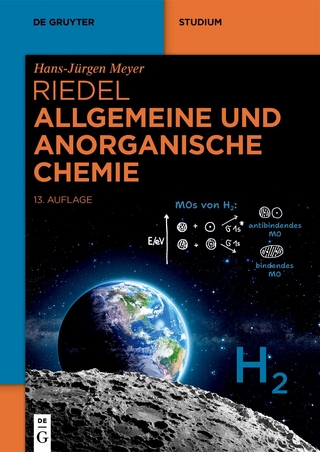
Low-Frequency Vibrations of Inorganic and Coordination Compounds
Kluwer Academic/Plenum Publishers (Verlag)
978-0-306-30453-8 (ISBN)
- Titel ist leider vergriffen;
keine Neuauflage - Artikel merken
Many titles do not pertain primarily to the far-infrared region as such, and some of this research has been omitted for this reason. Organometallic compounds have been neglected since the author feels that adequate reviews of that subject are available. Other studies may be missing simply because, owing to space limitations, only the more important researches could be considered. Of course, "importance" may, in this case, reflect the author's interest and prejudices.
1 Introduction.- 1.1. History.- 1.2. Usefulness of the Far-Infrared Region.- 1.3. Problems and Remedies.- Instrumental Problems.- Source.- Detector.- Amplification.- Miscellaneous Problems.- Sampling Problems.- Interpretative Problems.- 2 Far-Infrared Instrumentation.- 2.1. Introduction.- 2.2. Present Commercial Grating/Prism Instruments.- Beckman Prism and/or Grating Instruments.- IR-11 Infrared Spectrophotometer.- IR-12, IR-9, and IR-20 Infrared Spectrophotometers.- Perkin-Elmer Prism and/or Grating Instruments.- Model 301.- Model 621.- Model 225.- Hitachi FIS-3.- Grubb Parsons Prism and/or Grating Instruments.- Grubb Parsons DM 4.- Grubb Parsons GM 3.- 2.3. Present Commercial Interferometric Instruments.- Types of Interferometers.- Michelson Interferometers.- FS-720 and FS-820.- Grubb Parsons/N.P.L. Cube Interferometer MK 11.- Grubb Parsons Iris Interferometric Spectrometer.- Dunn Associates, Inc., Block FTS-16.- Dunn Associates, Inc., Block FTS-14.- Coderg Co. MIR 2.- Lamellar Grating Interferometers.- Beckman Instruments Co. LR-100.- Perkin-Elmer Corp. Model 180.- 2.4. Comparison of the Interferometer with the Conventional Spectrometer.- 2.5. Trends in Far-Infrared Instrumentation.- 3 Sampling Techniques and Instrument Calibration in the Far-Infrared Region.- 3.1. Introduction.- 3.2. Window Materials for Cells.- Plastic Windows.- Salt-Type Windows.- Silicon, Germanium, and Diamond Windows.- Quartz and Mica.- 3.3. Far-Infrared Solvents.- 3.4. Sampling Techniques.- 3.5. Calibration of Far-Infrared Instruments.- Rotation Spectra of Gases.- Mercury Lines.- Mercuric Oxide.- 4 New Techniques Used with Far-Infrared Measurements.- 4.1. Introduction.- 4.2. The Slow-Neutron Scattering (SNS) Technique.- Theory.- Instrumentation.- Applications.- 4.3. High-Pressure Techniques in the Far-Infrared Region.- Instrumentation.- Applications.- Lattice Vibrations.- Internal Vibrations.- 5 Metal-Oxygen Vibrations.- 5.1. Metal-Oxygen Vibrations in Hydrates.- 5.2. Metallic Oxides.- 5.3. Metal-Oxygen Vibrations in Hydroxyl-Bridged Complexes.- 5.4. Metal-Oxygen Vibrations in Salts Involving Oxygenated Polyatomic Anions.- D3h Symmetry-Nitrates, Carbonates, and Borates.- Td Symmetry-Sulfates, Selenates, Phosphates, Tungstates, Permanganates, Chromates, Molybdates, and Perchlorates.- C3? Symmetry-Chlorates, Bromates, Iodates, Sulfites, and Selenites.- 5.5. ?-Diketone Complexes.- 5.6. Complexes of Organic Acids.- Oxalato Complexes.- Amino Acid Complexes.- Glycolato Complexes.- Biuret Complexes.- 5.7. Complexes of Organic Oxide Ligands.- 5.8. Miscellaneous Complexes.- Peroxy Complexes.- Alkoxides.- Aluminates.- Sulfoxide Complexes.- 5.9. Nature of the Metal-Oxygen Vibration.- 5.10. Raman Spectroscopic Studies.- 6 Metal-Halide Vibration.- 6.1. Introduction.- 6.2. Hepta- and Octacoordinated Molecules-MX7, MX8 (CN = 7, 8).- 6.3. Hexacoordinated Molecules-Oh Symmetry (CN = 6).- The Hexafluorides-MX6 (Gaseous).- Anionic Hexahalides (MX6n-).- Hexafluorides (MF6n-).- Other Hexahalides (MX6n-, X = Cl, Br, I).- 6.4. Pentacoordinated Molecules-MX5, MX5n- (CN = 5).- 6.5. Tetracoordinated Molecules-MX4, MX4n- (CN = 4).- Tetrahedral Molecules and Ions.- Square Planar Ions-MX4n-.- 6.6. Tricoordinated Molecules-MX3 (CN = 3).- 6.7. Dicoordinated Molecules-MX2 (CN = 2).- Gaseous MX2 Compounds.- Solid MX2 Compounds.- 6.8. MX-Type Metal Halides.- 6.9. Miscellaneous Metal Halide Vibrations.- Oxyhalides.- Xenon Halides.- 6.10. Complexes Involving Organic Ligands.- LXM- and LMX2-Type Complexes.- LMX3- and LMX3--Type Complexes.- L2MX2-Type Complexes.- L2M2X4-, L3MX3-, and L4MX2-Type Complexes.- L5MX- and L5MXn--Type Complexes.- LMX5n-, L2MX4n-, and L3MX3n-- Anion-Type Complexes.- 2,2?-Bipyridyl and 1,10-Phenanthroline Complexes.- L3SnX-, L2SnX2-, and LSnCl3-Type Complexes.- Metal Ammine Complexes.- Miscellaneous.- 6.11. Bridged Metal Halide Vibrations.- 6.12. Summary.- Streochemistry and Coordination Number.- Oxidation Number.- Effect of Ligand Field Stabilization Energy on ?mx in Transition Metal Complexes.- Effect of Counter-Ion on ?mx Vibration.- Effect of Mass on ?mx Vibration.- Differentiation Between Bridged and Nonbridged ?mx Vibrations.- 7 Metal-Nitrogen Vibration.- 7.1. Introduction.- 7.2. Metal Ammine Complexes.- 7.3. Complexes of 2,2?-Bipyridyl, 2,2?,2?-Terpyridyl, 1,10-Phenanthroline, Aniline, and 8-Aminoquinoline.- 7.4. Metal-Imidazole Complexes and Complexes with Substituted Imidazoles.- 7.5. Metal-Pyridine and Related Complexes.- LXM2 Complexes.- LMX3 and LMX3- Complexes.- L15MX3 Complexes.- L2(OR)CuX2 Complexes.- L2MX2 Complexes.- Distorted Polymeric Octahedral Complexes.- Polymeric Octahedral Complexes.- Tetrahedral Complexes.- Planar Complexes.- L2MX4, [L2MX4]Y, and L2M3X6 Complexes.- L2MX3 and L3MX2 Complexes.- L4MX2 Complexes.- 7.6. Metal-Ethylenediamine and Related Complexes.- 7.7. Metal-Hydrazine Complexes.- 7.8. Metal Complexes Containing Nitrile Groups.- 7.9. Metal Isothiocyanate and Related Complexes.- 7.10. Metal-Amino Acid Complexes.- 7.11. Metal-Nitro Complexes.- 7.12. Metal-Azide Complexes.- 7.13. Metal-Nitrosyl Complexes.- 7.14. Summary.- Oxidation Number.- Stereochemistry and Coordination Number.- Basicity of Ligand.- 8 Miscellaneous Metal-Ligand Vibrations.- 8.1. Introduction.- 8.2. Metal-Sulfur Vibrations.- 8.3. Metal-Selenium Vibrations.- 8.4. Metal-Tellurium Vibrations.- 8.5. Metal-Phosphorus Vibrations.- 8.6. Metal-Arsenic Vibrations.- 8.7. Metal-Metal Vibrations.- 8.8. Summary of the ?MC and ?MCX Vibrations.- 9 Other Low-Frequency Vibrations.- 9.1. Ion-Pair Vibrations.- 9.2. Low-Frequency Vibrations of Molecules Trapped in Clathrates.- 9.3. Electronic Transitions.- 9.4. Lattice Vibrations.- 9.5. Miscellaneous Vibrations.- Appendixes.- Appendix 1. Selection Rules and Correlation Charts.- Site Symmetries for the 230 Space Groups.- Correlation Tables for the Species of a Group and Its Subgroups.- Appendix 2. Procedure Used for Factor Group Analysis of Solids.
| Erscheint lt. Verlag | 31.12.1995 |
|---|---|
| Zusatzinfo | biography |
| Sprache | englisch |
| Themenwelt | Naturwissenschaften ► Chemie ► Anorganische Chemie |
| ISBN-10 | 0-306-30453-8 / 0306304538 |
| ISBN-13 | 978-0-306-30453-8 / 9780306304538 |
| Zustand | Neuware |
| Informationen gemäß Produktsicherheitsverordnung (GPSR) | |
| Haben Sie eine Frage zum Produkt? |
aus dem Bereich


